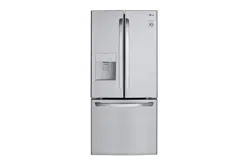Documents: Go to download!
- Owner's manual - (English)
- Refrigerator Installation
- INSTALLATION
- USING YOUR REFRIGERATOR
- WATER FILTER
- CARE AND CLEANNING
- TROUBLESHOOTING GUIDE
Table of contents
Refrigerator Installation
UNPACKING
- This appliance is intended to be used in household and similar applications such as:
- Staff kitchen areas in shops, offices and other working environments; farms houses and by clients in hotel, motels and others residential type environments.
- Bed and breakfast type environments; catering and similar non-retail applications.”
- To remove adhesive tape residue, rub it well with your fingers and a little liquid detergent. Clean with warm water and let dry.
- Do not use sharp instruments, rubbing alcohol, flammable liquids or abrasive cleaning products to remove the adhesive tape or glue. These products can damage the surface of your refrigerator. For more information, see the section on “Important Safety Instructions”.
- The shelves come already installed in their factory position. Remove the shelves and replace them according to your spacing needs.
Moving Your Refrigerator:
- Your refrigerator is extremely heavy. Make sure you protect the floor when moving your refrigerator for cleaning or servicing.
- Always pull your refrigerator straight out when moving it. Do not shift from side to side or “walk” the refrigerator when attempting to move it as this can cause damage to the floor.
WARNING EXPLOSION HAZARD
- Keep all flammable materials and vapors (such as gasoline) away from the refrigerator. Not following these instructions may cause death, explosion or fire.
INSTALLATION
- Avoid placing the unit near heat sources, direct sunlight, or humidity.
- To avoid vibration, the unit should be leveled. If needed, adjust the leveling screws to compensate for an unleveled floor. The front should be slightly taller than the rear to ensure that the doors close properly.
- The leveling screws can easily be turned by slightly tilting the front of the refrigerator, turning the leveling screws clockwise ( ) to raise it and counter-clockwise to lower it.
- Install the refrigerator in an area between 55 °F C) and 110 °F (43 °C). If the surrounding temperature is lower or higher than previously mentioned, it can adversely affect the unit.
CAUTION: Avoid placing the unit near heat sources, direct sunlight or humidity.
ONCE INSTALLED
- Carefully clean your refrigerator and remove and dust accumulated during shipping.
- Install accessories such as the ice bin, door racks, shelves, etc., in their proper places. These are already packed to prevent any possible damage during shipping.
- Leave your refrigerator on for 2 to 3 hours before storing food inside. Verify that there is a flow of cold air in the freezer compartment to ensure proper cooling.
- Your refrigerator is now ready for use.
WARNING:
- Take care when working with the hinges, base cover and stops, etc. You may injure yourself.
- DO not place your hands or any tools in the air vents, the base cover or in the bottom of the refrigerator. This may cause injury or electrical shock.
- Keep a Proper Distance from Adjacent
Flooring
- To avoid noise and vibration, the unit must be leveled and installed on a solidly constructed floor. If required, adjust the leveling legs to compensate for unevenness of the floor.
- The front should be slightly higher than the rear to aid in door closing. Leveling legs can be turned easily by tipping the cabinet slightly. Turn the leveling legs to the left to raise the unit or to the right to lower it. (See Leveling and Door Alignment.)
Objects
- Please keep the refrigerator at an adequate distance from other objects. Insufficient spacing can reduce the refrigerator’s freezing efficiency and increase electricity consumption. cm) 2”
- Before installing your refrigerator, remove any tape or temporary stickers. Please remove vinyl from doors before connecting unit to the electrical supply (on some models). Do not remove any stickers that feature warnings, the model serial number or the technical label of the product located on the back of the refrigerator.
HOW TO REMOVE AND INSTALL THE REFRIGERATOR DOORS
For moving the refrigerator through a house door, it might be necessary to remove refrigerator and freezer door handles.

NOTE:
- Removing the doors is always recommended when it is necessary to move the refrigerator through a narrow opening. If it is necessary to remove the handles, follow the directions below.
TOOLS YOU MIGHT NEED OR USE in (10 mm) in (6 mm)
- Hex Socket Wrench Phillips Screwdriver Flat Head Screwdriver Allen Wrench
HOW TO REMOVE REFRIGERATOR DOOR HANDLE
NOTE: Handle appearance may vary from illustrations on this page.
Loosen the set screws with a 3/32 in (2,5 mm). Allen wrench and remove the handle.

NOTE: If the handle mounting fasteners need to be tightened or removed, use a 1/4 in (6 mm). Allen wrench.
HOW TO REPLACE REFRIGERATOR DOOR HANDLE
NOTE: Handle appearance may vary from illustrations on this page.
- Place the handle on the door by fitting the handle footprints over the mounting fasteners and tightening the set screws with a 3/32 in (2,5 mm) Allen wrench.
NOTE: If the handle mounting fasteners need to be tightened or removed, use a in (6 mm) Allen wrench.
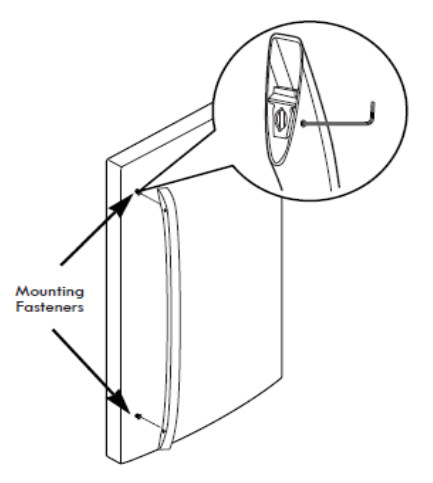
HOW TO REMOVE FREEZER DOOR HANDLE
NOTE: Handle appearance may vary from illustrations on this page.

- Loosen the set screws located on the lower side of the handle with a 3/32 in (2,5 mm). Allen wrench and remove the handle.
NOTE: If the handle mounting fasteners need to be tightened or removed, use a 1/4 in (6 mm). Allen wrench.
HOW TO REPLACE FREEZER DOOR HANDLE
NOTE: Handle appearance may vary from illustrations on this page.
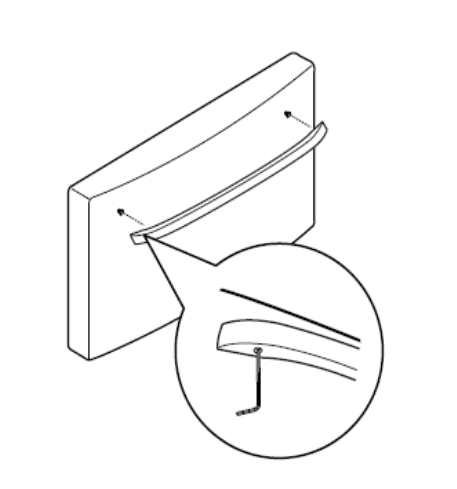
- Place the handle on the door by fitting the handle footprints over the mounting fasteners and tightening the set screws with a 3/32 in (2,5 mm). Allen wrench.
NOTE: If the handle mounting fasteners need to be tightened or removed, use a 1/4 in (6 mm). Allen wrench
To remove the left refrigerator door:
- On the back of the refrigerator, pull the water tube out of the collet fitting on the connector by pressing the fitting release ring (see picture below).

- Open the door. Remove the top hinge cover screw (1).
- Lift up the cover (2).
- Remove the cover.
- Pull out the tube (3).
- Disconnect all wire harnesses (4).
- Remove the grounding screw (5).
- Remove the three bolts (6) using a 10mm socket wrench. Lift off the top hinge (7).
CAUTION:
- When lifting the hinge, be careful that the door does not fall forward.
- Lift the door from the middle hinge pin and remove the door.
- Place the door, inside facing up, on a non-scratching surface.
To remove the right refrigerator door:
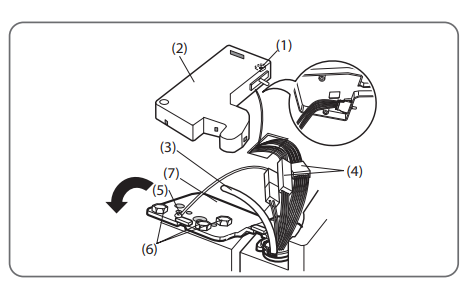
Open the door. Remove the top hinge cover screw (1).
Lift up the cover (2).
Remove the cover.
Remove the three bolts (3) using a 10mm socket wrench. Lift off the top hinge (4)
CAUTION: When lifting the hinge, be careful that the door does not fall forward.
Lift the door from the middle hinge pin and remove the door.
Place the door, inside facing up, on a non-scratching surface.
Reinstalling the Refrigerator Door
Left Door
Lower the door onto middle hinge pin (10).

- Line up the holes in the top hinge with the holes in the top of the refrigerator. Insert and tighten the three Bolts (6) in the hinge.
- Install the grounding screw (5) and connect the two wire harnesses (4).
- Push the water tube (3) located at the top of the left door into the hole beside the left hinge on the top of the cabinet until it exits through the back.
- Insert the water supply tube (3) into the connector until you see only one scale mark. Fully insert the tube over 5/8 in. (15 mm).
- Hook tabs on left side of hinge cover (1) under the edge of the top hinge (7) and position the cover in place. Insert and tighten the cover screw (1).
Right Door
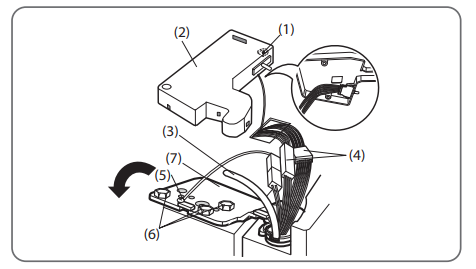
Lower the door onto middle hinge pin (9).
Line up the holes in the top hinge with the holes in the top of the refrigerator. Insert and tighten the three
Bolts (6) in the hinge.
Hook the tabs on right side of hinge cover (2) under the edge of the top hinge (4) and position the cover in place. Insert and tighten the cover screw (1).
HOW TO REMOVE THE FREEZER DRAWER
WARNING: Use two or more people to remove and install the freezer drawer. Failure to do so can result in back or other injury.
Remove the screws (2) of the rail on both sides.
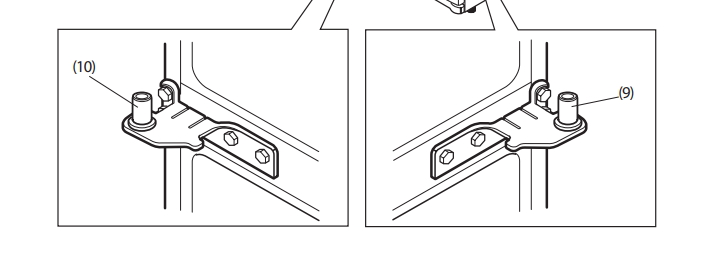
Grasp the drawer on each side and pull it up to separate it from the rails.
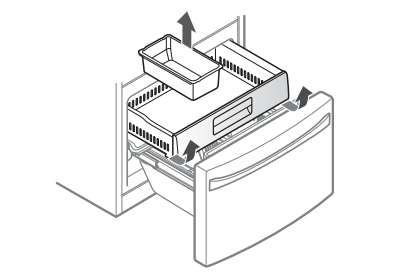
With both hands, hold the center bar and push it in to allow both rails to slide in simultaneously.
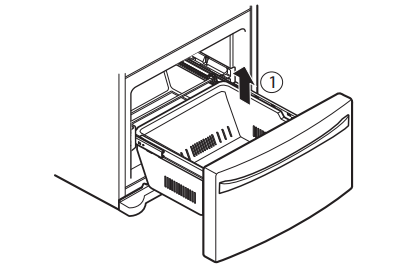
CAUTION: Do not hold the handle when removing or replacing the drawer. The handle may come off, causing personal injury.
Pull the drawer open to full extension. Remove the lower basket 1 by lifting the basket from the rail system.
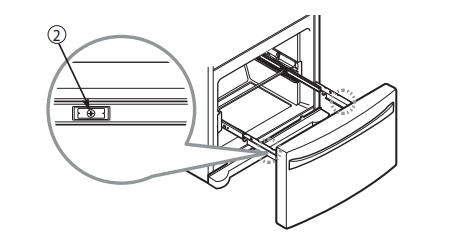
Leveling
- Door Alignment
- If the space between your doors is uneven, follow the instructions below to align the doors:
- With one hand, lift up the door that you would like to raise at the middle hinge.
- With your other hand, use pliers to insert snap ring as shown.
- Insert additional snap rings until the doors are aligned.
- Three snap rings are provided with the refrigerator in the
- Use & Care Guide packet.)
REFRIGERATOR INSTALLATION
- After installing, plug the refrigerator’s power cord into a 3-prong grounded outlet and push the refrigerator into the final position.
- Your refrigerator has two front leveling legs—one on the right and one on the left. Adjust the legs to alter the tilt from frontto-back or side-to-side. If your refrigerator seems unsteady, or you want the doors to close more easily, adjust the refrigerator’s tilt using the instructions below:
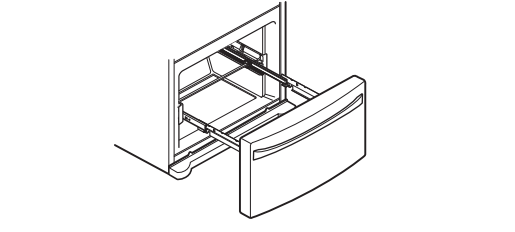
NOTE: Tools Required: 11/16 in (18 mm) wrench or flat blade screwdriver.
- Turn the leveling leg to the left to raise that side of the refrigerator or to the right to lower it. It may take several turns of the leveling leg to adjust the tilt of the refrigerator
NOTE: Having someone push backward against the top of the refrigerator takes some weight off of the leveling legs. This makes it easier to adjust the legs.
- Open both doors again and check to make sure that they close easily. If the doors do not close easily, tilt the refrigerator slightly more to the rear by turning both leveling legs to the left. It may take several more turns, and you should turn both leveling legs the same amount.
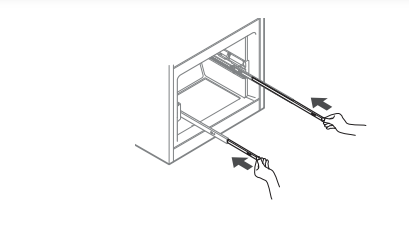
NOTE: Your refrigerator is uniquely designed with two fresh food doors. Either door can be opened or closed independently of the other. You may have to exert slight pressure on the doors to get them to close completely
USING YOUR REFRIGERATOR
SETTING THE CONTROLS
AIRFLOW
- The refrigerator control functions as the thermostat for the entire appliance (refrigerator and freezer sections).
- The colder the setting, the longer the compressor will run to keep the temperature colder. The freezer control adjusts the cold air flow from the freezer to the refrigerator.
- Setting the freezer control to a lower temperature keeps more cold air in the freezer compartment to make it colder.
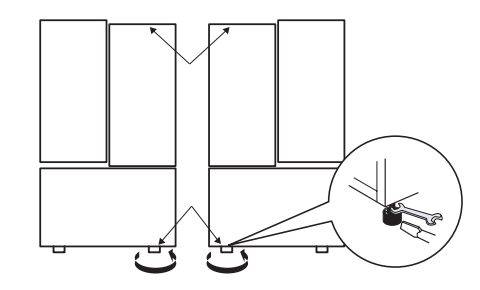
- Cold air circulates from the freezer to the fresh food section and back again through air vents in the wall dividing the two sections.
- Be sure not to block vents while packing your refrigerator. Doing so will restrict airflow and may cause the refrigerator temperature to become too warm or cause interior moisture buildup. (See air flow diagram below.)
Temperature
The Refrigerator Temp Control ranges from 33°F to
F (0°C to 8°C). Press the Refrigerator button to cycle through the available temperature settings one increment at a time.
The Freezer Temp Control range is from -6°F to 8°F
C to -13°C). Press the Freezer button to cycle through the available temperature settings one increment at a time.

NOTE: When changing control settings, wait 24 hours before making additional adjustments. The controls are set correctly when milk or juice is as cold as you would like and when ice cream is firm. If the temperature in either compartment is too cold or too warm, change the setting one increment at a time. Wait 24 hours for the change to stabilize before adjusting again.
Dispenser
- Some dripping may occur after dispensing water. Hold your cup beneath the dispenser for a few seconds after dispensing to catch all of the drops.
NOTE: The dispenser will not work if any door is left open or if the control lock is engaged.
Express Freeze
- When you press the Express Freeze button, the Express
- Freeze graphic will illuminate in the display and will continue for 24 hours. The function will automatically shut off after 24 hours.
- You can stop this function manually by touching the button one more time.
- This function increases both ice making and freezing capabilities.
Water Filter
- When the water filter indicator turns on, you have to change the water filter. After changing the water filter, press and hold the Express Freeze /
- Water filter button for three seconds to turn the indicator light off. You need to change the water filter approximately every six months.
Light
- Press the Light button to turn the light on and off. When dispensing water, a light underneath the water switch will illuminate.
Articulating Mullion
- This feature is a metal strip attached to the left door that articulates (rotates) 90 degrees as the door is closed, forming a mullion (base) for the left and right door gaskets to seal against.
Caution When Closing the Door
CAUTION
- To reduce the risk of scratching the door or breaking the door mullion, please make sure that the refrigerator door mullion is always folded in.
Door Alarm
- When power is connected to the refrigerator, the door alarm is initially set to ON. When you press the Door
- Alarm button, the display will change to OFF and the
- Door Alarm function will deactivate.
- When either the refrigerator or the freezer door is left open for more than 60 seconds, the alarm tone will sound to let you know that the door is open.
- When you close the door, the door alarm will stop.
Lock
- When power is initially connected to the refrigerator, the
- Lock function is off.
- If you want to activate the Lock function to lock other buttons, press and hold the Door Alarm button for three seconds or more. The Lock icon will display and the Lock function is now enabled.
- When the Lock function is activated, no other buttons will work. The dispenser pad is also deactivated.
- To disable the Lock function, press and hold the Door
- Alarm button for approximately three seconds.
Display Mode (For Store Use Only)
- The Display Mode disables all cooling in the refrigerator and freezer sections to conserve energy while on display in a retail store. When activated, OFF will display on the control panel.
To deactivate:
- With either refrigerator door opened, press and hold the
- Refrigerator and Express Freeze buttons at the same time for five seconds. The control panel will beep and the temperature settings will display to confirm that
- Display Mode is deactivated. Use the same procedure to activate the Display Mode
AUTOMATIC ICEMAKER
- The icemaker will produce approximately 70-210 cubes in a 24-hour period, depending on freezer compartment temperature, room temperature, number of door openings and other operating conditions.
- It takes about 12 to 24 hours for a newly installed refrigerator to begin making ice. Wait 72 hours for full ice production to occur.
- Ice making stops when the in-door ice bin is full. When full, the in-door ice bin holds approximately 6-8 (12-16 oz) glasses of ice.
- To turn off the automatic icemaker, set the icemaker switch to OFF (O). To turn on the automatic icemaker, set the switch to ON (I).
- The water pressure must be between 20 and 120 psi
- MPa) on models without a water filter and between 40 and 120 psi (0,28 ~ 0,82 MPa) on models with a water filter to produce the normal amount and size of ice cubes.
- Foreign substances or frost on the ice-detecting sensor can interrupt ice production. Make sure the sensor area is clean at all times for proper operation.
CAUTION
- The fi rst ice produced after installation may include particles or odor from the water supply line or the water tank. Throw away the fi rst few batches of ice (about 24 cubes). This is also necessary if the refrigerator has not been used for a long time.
- If discolored ice is produced, check the water supply.
- If the problem continues, contact a qualified service center. Do not use the ice or water until the problem is corrected.
- Be sure nothing interferes with the sweep of the
Automatic Shut Off Arm.
- When the bin fi lls to the level of the Automatic Shut
- Off Arm, the icemaker will stop producing ice.
- It is normal for some cubes to be stuck together.
- If ice is not used frequently, old ice cubes will become cloudy, taste stale, and shrink.
- Never store beverage cans or other items in the ice bin for the purpose of rapid cooling. Doing so may damage the icemaker or the containers may burst.
- Never use thin crystal glass or crockery to collect ice.
- Such containers may chip or break resulting in glass fragments in the ice.
WHEN YOU SHOULD SET THE ICEMAKER POWER SWITCH TO OFF (O)
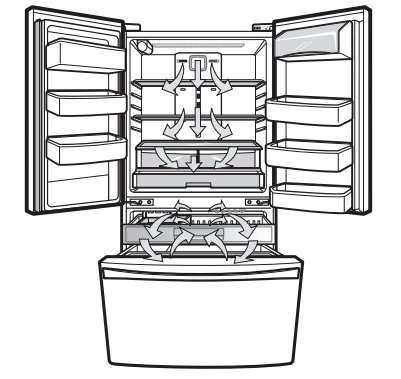
- When the water supply will be shut off for several hours.
- When the ice bin is removed for more than one or two minutes.
- When the refrigerator will not be used for several days.
NOTE: The ice bin should be emptied when the icemaker ON/OFF switch is turned to the OFF position.
NORMAL SOUNDS YOU MAY HEAR
- The icemaker water valve will buzz as the icemaker fills with water. If the power switch is in the ON (I) position, it will buzz even if it has not yet been hooked up to water. To stop the buzzing, move the power switch to
NOTE: Keeping the power switch in the ON (I) position before the water line is connected can damage the icemaker.
You will hear the sound of cubes dropping into the bin and water running in the pipes as the icemaker refills.
PREPARING FOR VACATION
Set the icemaker power switch to OFF (O) and shut off the water supply to the refrigerator.
NOTE: The ice bin should be emptied anytime the icemaker ON/OFF switch is turned to the OFF (O) position.
- If the ambient temperature will drop below freezing, have a qualified technician drain the water supply system to prevent serious property damage due to fl ooding caused by ruptured water lines or connections.
FOOD STORAGE GUIDE
- Wrap or store food in the refrigerator in airtight and moisture-proof material unless otherwise noted. This prevents food odor and taste transfer throughout the refrigerator. For dated products, check date code to ensure freshness.
- Keep opened butter in a covered dish or closed compartment. When storing an extra supply, wrap in freezer packaging and freeze.
- Store in the original wrapping until you are ready to use it. Once opened, rewrap tightly in plastic wrap or aluminum foil.
- Wipe milk cartons. For best storage, place milk on interior shelf.
- Store in original carton on interior shelf, not on door shelf.
- Do not wash or hull the fruit until it is ready to be used. Sort and keep fruit in its original container, in a crisper, or store in a completely closed paper bag on a refrigerator shelf.
- Remove store wrapping and trim or tear off bruised and discolored areas. Wash in cold water and drain. Place in plastic bag or plastic container and store in crisper.
- Place in plastic bags or plastic container and store in crisper.
- Store fresh fish and shellfish in the freezer section if they are not being consumed the same day of purchase.
- It is recommended to consume fresh fish and shellfish the same day purchased.
- Leftovers Cover leftovers with plastic wrap, aluminum foil, or plastic containers with tight lids.
STORING FROZEN FOOD
NOTE: Check a freezer guide or a reliable cookbook for further information about preparing food for freezing or food storage times.
Freezing
- Your freezer will not quick-freeze a large quantity of food.
- Do not put more unfrozen food into the freezer than will freeze within 24 hours, no more than 2 to 3 lbs. of food per cubic foot ( 1 to 1,5 kg of food per each 30 liters ) of freezer space. Leave enough space in the freezer for air to circulate around packages. Be careful to leave enough room at the front so the door can close tightly.
- Storage times will vary according to the quality and type of food, the type of packaging or wrap used (how airtight and moisture-proof) and the storage temperature. Ice crystals inside a sealed package are normal. This simply means that moisture in the food and air inside the package have condensed, creating ice crystals.
NOTE: Allow hot foods to cool at room temperature for minutes, then package and freeze. Cooling hot foods before freezing saves energy.
Packaging
- Successful freezing depends on correct packaging.
- When you close and seal the package, it must not allow air or moisture in or out. If it does, you could have food odor and taste transfer throughout the refrigerator and could also dry out frozen food.
- Packaging recommendations:
- Rigid plastic containers with lids
- Straight-sided canning/freezing jars
- Heavy-duty aluminum foil
- Plastic-coated paper
- Non-permeable plastic wraps freezer-grade self-sealing plastic bags
- Follow package or container instructions for proper freezing methods.
- Do not use
- Bread wrappers
- Non-polyethylene plastic containers
- Containers without tight lids
- Wax paper or wax-coated freezer wrap
- Thin, semi-permeable wrap
REFRIGERATOR SHELVES
To remove a shelf —Tilt up the front of the shelf 1 and lift it 2 . Pull the shelf out.
CAUTION:
To reinstall a shelf —Tilt the front of the shelf up and guide the shelf hooks into the slots at a desired height 3 . Then, lower the front of the shelf so that the hooks drop into the slots 4 .
HUMIDITY CONTROLLED CRISPER

The crispers provide fresher tasting fruit and vegetables by letting you easily control humidity inside the drawer.
You can control the amount of humidity in the moisture sealed crispers by adjusting the control to any setting between VEGETABLE and FRUIT.
VEGETABLE keeps moist air in the crisper for best storage of fresh, leafy vegetables.
FRUIT lets moist air out of the crisper for best storage of fruit.
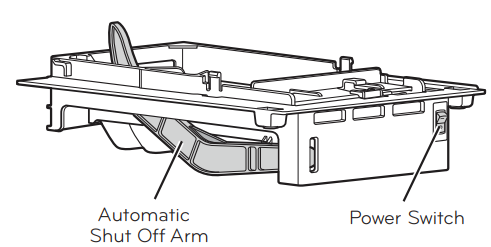
REMOVING THE HUMIDITY CONTROLLED CRISPER
To remove, pull the drawer out to full extension.
Lift the front of the crisper up, then pull it straight out.
To install, slightly tilt up the front, insert the drawer into the frame and push it back into place.
To remove the glass
Lift up the glass under the crisper cover.
Pull the glass up and out.
NOTE: Pantry drawer not shown for clarity.
The shelves in your refrigerator are adjustable to meet your individual storage needs. Your model may have full or split shelves.
Adjusting the shelves to fit different heights of items will make finding the exact item you want easier. Doing so will also reduce the amount of time the refrigerator door is open which will save energy.
IMPORTANT: Do not clean glass shelves with warm water while they are cold. Shelves may break if exposed to sudden temperature changes or impact.
NOTE: Glass shelves are heavy. Use special care when removing them.
Adjusting Shelves (Split Shelf)
Remove shelves from the shipping position and replace shelves in the position you want.
The shelves in your refrigerator are adjustable to meet your individual storage needs. Your model may have full or split shelves.
Adjusting the shelves to fit different heights of items will make fi nding the exact item you want easier. Doing so will also reduce the amount of time the refrigerator door is open which will save energy
WATER FILTER
- It is recommended that you replace the water filter:
- Approximately every 6 months.
- When the water er indicator turns on.
- When the water dispenser output decreases.
- When the ice cubes are smaller than normal.
- Remove the old water filter.
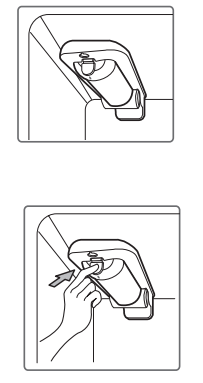
- Lower or remove the top left shelf to allow the water filter to rotate all the way down.
- Press the push button to open the water filter cover.
- NOTE: Replacing the water filter causes a small amount of water around 1 oz. or 25 cc) to drain.
- Before pushing the button to open the water filter cover, place a cup under the front end of the cover to collect any leaking water.
- Hold the water filter upright, once itis removed, to prevent any remaining water from spilling out of the water filter.
- Pull the water er downward and pull out. Make sure to rotate the filter down completely before pulling it out of the manifold hole.
- Replace with a new water filter.

Take the new water er out of its packaging and remove the protective cover from the o-rings. With water filter tabs in the horizontal position, push the new water filter into the manifold hole until it stops.
Rotate the water er up into position and close the cover.
The cover will click when closed correctly.
After the water filter is replaced, dispense 2.5 gallons liters) of water (flush for approximately 5 minutes) to remove trapped air and contaminates from the system.
Do not dispense the entire 2.5 gallon (9 liters) amount continuously. Depress and release the dispenser pad for cycles of 30 seconds ON and 60 seconds OFF.
Water Filter Bypass Plug
Keep the water filter bypass plug. You MUST use the water filter bypass plug when a replacement water filter cartridge is not available.
CAUTION: DO NOT operate refrigerator without water filter or water filter plug installed.
NOTE: To purchase replacement water filter cartridges, visit your local appliance dealer or parts distributor.
CARE AND CLEANNING
EXTERIOR
- Waxing external painted metal surfaces helps provide rust protection. Do not wax plastic parts. Wax painted metal surfaces at least twice a year using appliance wax or auto paste wax). Apply wax with a clean, soft cloth.
- For products with a stainless steel exterior, use a clean sponge or soft cloth and a mild detergent in warm water.
- Do not use abrasive or harsh cleaners. Dry thoroughly with a soft cloth.
INSIDE WALLS (allow freezer to warm up so the cloth will not stick)
- To help remove odors, you can wash the inside of the refrigerator with a mixture of baking soda and warm water.
- Mix 2 tablespoons of baking soda to 1 quart of water (26 g soda to 1 liter water.) Be sure the baking soda is completely dissolved so it does not scratch the surfaces of the refrigerator.
CAUTION: While cleaning the inside, do not spray water.
DOOR LINERS AND GASKETS
Use a clean sponge or soft cloth and a mild detergent in warm water. Do not use cleaning waxes, concentrated detergents, bleaches, or cleaners containing petroleum on plastic refrigerator parts.
PLASTIC PARTS (Covers and Panels)
Use a clean sponge or soft cloth and a mild detergent in warm water. Do not use window sprays, abrasive cleansers, or flammable fluids. These can scratch or damage the material.
CONDENSER COILS
Use a vacuum cleaner with an attachment to clean the condenser cover and vents. Do not remove the panel covering the condenser coil area.
POWER INTERRUPTIONS
If the power will be out for 24 hours or less, keep all refrigerator doors closed to help foods stay cold and frozen.
If the power will be out for more than 24 hours, remove all frozen food and store it in a frozen food locker.
WHEN YOU GO ON VACATION
- If you choose to leave the refrigerator on while you are away, follow these steps to prepare your refrigerator before you leave.
- Use up any perishables and freeze other items.
- Turn off the icemaker and empty the ice bin.
- If you choose to turn the refrigerator off before you leave, follow these steps.
- Remove all food from the refrigerator.
- Depending on your model, set the thermostat control refrigerator control) to OFF. See the Setting the Controls section.
- Clean the refrigerator, wipe it and dry well.
- Tape rubber or wood blocks to the tops of both doors to prop them open far enough for air to get in. This stop odor and mold from building up.
WHEN YOU MOVE
- When you are moving your refrigerator to a new home, follow these steps to prepare it for the move.
- Remove all food from the refrigerator and pack all frozen food in dry ice.
- Unplug the refrigerator.
- Clean, wipe and dry thoroughly.
- Take out all removable parts, wrap them well and tape them together so they do not shift and rattle during the move. Refer to the Using your Refrigerator section for removable instructions.
- Depending on the model, raise the front of the refrigerator so it rolls easier OR screw in the leveling legs all the way so they do not scrape the floor. See the Door
- Closing section.
- Tape the doors shut and tape the power cord to the refrigerator cabinet.
- When you get to your new home, put everything back and refer to the Refrigerator Installation section for preparation instructions.
TROUBLESHOOTING GUIDE
FLUSH OUT THE TUBING
- Turn the main water supply on and flush out the tubing until the water is clear.
- Shut the water off at the water valve after about one quart of water has been flushed through the tubing.
CONNECT THE TUBING TO THE REFRIGERATOR
- Before making the connection to the refrigerator, be sure that the refrigerator power cord is not plugged into the wall outlet. a.
- Remove the plastic flexible cap from the water valve. b. Place the compression nut and ferrule (sleeve) onto the end of the tubing as shown. c. Insert the end of the copper tubing into the connection as far as possible. While holding the tubing, tighten the fitting
PLUG IN THE REFRIGERATOR
- Arrange the coil of tubing so that it does not vibrate against the back of the refrigerator or against the wall.
- Push the refrigerator back to the wall.
START THE ICEMAKER
Set the icemaker power switch to the ON position.
[IMAGE]
The icemaker will not begin to operate until it reaches its operating temperature of 15°F (–9°C) or below. It will then begin operation automatically if the icemaker power switch is in the ON (I) position.
Refrigerator and Freezer section are not cooling.
- The refrigerator control is set to OFF (some models).
- Refrigerator is set to Display Mode.
- Refrigerator is in the defrost cycle.
- Refrigerator was recently installed.
- Refrigerator was recently relocated.
- Turn the control ON. Refer to the Setting the Controls section for proper temperature settings.
- Display Mode allows the lights and control display to work normally while disabling cooling to save energy while on the showroom floor. Refer to the Setting the Controls section for instructions on how to disable Display Mode.
- During the defrost cycle, the temperature of each compartment may raise slightly. Wait 30 minutes and confirm the proper temperature has been restored once the defrost cycle has completed.
- It may take up to 24 hours for each compartment to reach the desired temperature.
- If the refrigerator was stored for a long period of time or moved on its side, it is necessary for the refrigerator to stand upright for 24 hours before connecting it to power.
Cooling System runs too much.
- Refrigerator is replacing an older model.
- Refrigerator was recently plugged in or power restored.
- Door opened often or a large amount of food / hot food was added.
- Doors are not closed completely.
- Modern refrigerators require more operating time but use less energy due to more efficient technology.
- The refrigerator will take up to 24 hours to cool completely
- Adding food and opening the door warms the refrigerator, requiring the compressor to run longer in order to cool the refrigerator back down. In order to conserve energy, try to get everything you need out of the refrigerator at once, keep food organized so it is easy to find, and close the door as soon as the food is removed. (Refer to the Food Storage Guide.)
- Firmly push the doors shut. If they will not shut all the way, see the Doors will not close completely or pop open section in Parts & Features Troubleshooting.
Refrigerator or Freezer section is too warm.
- Refrigerator was recently installed.
- The air vents are blocked. Cold air circulates from the freezer to the fresh food section and back again through air vents in the wall dividing the two sections..
- Doors are opened often or for long periods of time.
- Unit is installed in a hot location.
- A large amount of food or hot food was added to either compartment.
- Doors not closed correctly.
- Temperature control is not set correctly
- Defrost cycle has recently completed.
- t may take up to 24 hours for each compartment to reach the desired temperature.
- Rearrange items to allow air to flow throughout the compartment. Refer to the Airflow diagram in the Using Your Refrigerator section.
- When the doors are opened often or for long periods of time, warm, humid air enters the compartment. This raises the temperature and moisture level within the compartment. To lessen the effect, reduce the frequency and duration of door openings
- The refrigerator should not be operated in temperatures above 110F (43°C ).
- Adding food warms the compartment requiring the cooling system to run. Allowing hot food to cool to room temperature before putting it in the refrigerator will reduce this effect.
- See the Doors will not close correctly or pop open section in Parts & Features Troubleshooting.
- If the temperature is too warm, adjust the control one increment at a time and wait for the temperature to stabilize. Refer to the Setting the Controls section for more information.
- During the defrost cycle, the temperature of each compartment may raise slightly and condensation may form on the back wall. Wait 30 minutes and confirm the proper temperature has been restored once the defrost cycle has completed.
Interior moisture buildup.
- Doors are opened often or for long periods of time.
- Doors not closed correctly.
- Weather is humid.
- Defrost cycle recently completed.
- Food is not packaged correctly.
- When the doors are opened often or for long periods of time, warm, humid air enters the compartment. This raises the temperature and moisture level within the compartment. To lessen the effect, reduce the frequency and duration of door openings.
- See the Doors will not close correctly section in the Troubleshooting section
- Humid weather allows additional moisture to enter the compartments when the doors are opened leading to condensation or frost. Maintaining a reasonable level of humidity in the home will help to control the amount of moisture that can enter the compartments.
- During the defrost cycle, the temperature of each compartment may raise slightly and condensation may form on the back wall. Wait 30 minutes and confirm that the proper temperature has been restored once the defrost cycle has completed.
- Food stored uncovered or unwrapped, and damp containers can lead to moisture accumulation within each compartment. Wipe all containers dry and store food in sealed packaging to prevent condensation and frost.
Food is freezing in the refrigerator compartment.
- Food with high water content was placed near an air vent.
- Refrigerator temperature control is set incorrectly.
- Refrigerator is installed in a cold location.
- Rearrange items with high water content away from air vents
- .If the temperature is too cold, adjust the control one increment at a time and wait for the temperature to stabilize. Refer to the Setting the Controls section for more information
- When the refrigerator is operated in temperature below 41°F (5°C), food can freeze in the refrigerator compartment. The refrigerator should not be operated in temperature below 55°F (13°C).
- When the doors are opened often or for long periods of time, warm, humid air enters the compartment. This raises the temperature and moisture level within the compartment. Increased moisture will lead to frost and condensation. To lessen the effect, reduce the frequency and duration of door openings.
- Refer to the Doors will not close correctly or pop open section in the Troubleshooting section.
Refrigerator or Freezer section is too cold
- Incorrect temperature control settings.
- If the temperature is too cold, adjust the control one increment at a time and wait for the temperature to stabilize. Refer to the Setting the Controls section for more information.
Frost or ice crystals on frozen food (inside of sealed package).
- Condensation from food with a high water content has frozen inside of the food package.
- Food has been left in the freezer for a long period of time.
- This is normal for food items with a high water content.
- Do not store food items with high water content in the freezer for a long period of time.
Icemaker is not making enough ice.
- Demand exceeds ice storage capacity
- House water supply is not connected, valve is not turned on fully, or valve is clogged.
- Water filter has been exhausted.
- Low house water supply pressure
- Reverse Osmosis filtration system is used.
- Tubing connecting refrigerator to house supply valve is kinked.
- The icemaker will produce approximately 100 cubes in a 24 hour period.
- Connect the refrigerator to a cold water supply with adequate pressure and turn the water shutoff valve fully open. If the problem persists, it may be necessary to contact a plumber
- The water pressure must be between 20 and 120 psi or 0,14 and 0,83 Mpa on models without a water filter and between 40 and 120 psi or 0,28 Mpa and 0,83 MPa on models with a water filter. If the problem persists, it may be necessary to contact a plumber.
- Reverse osmosis filtration systems can reduce the water pressure below the minimum amount and result in icemaker issues. (Refer to Water Pressure section.)
- The tubing can kink when the refrigerator is moved during installation or cleaning resulting in reduced water flow. Straighten or repair the water supply line and arrange it to prevent future kinks.
Icemaker is not making enough ice
- Doors are opened often or for long periods of time
- Doors are not closed completely.
- The temperature setting for the freezer is too warm.
- If the doors of the unit are opened often, ambient air will warm the refrigerator which will prevent the unit from maintaining the set temperature. Lowering the refrigerator temperature can help, as well as not opening the doors as frequently.
- If the doors are not properly closed, ice production will be affected. See the Doors will not close completely or pop open section in Parts & Features Troubleshooting for more information.
- The recommended temperature for the freezer compartment for normal ice production is 0°F. If the freezer temperature is warmer, ice production will be affected.
Dispensing water slowly
- Water filter has been exhausted.
- Reverse osmosis filtration system is used
- Low house water supply pressure
- It is recommended that you replace the water filter:
- •Approximately every six months.
- •When the water er indicator turns on.
- •When the water dispenser output decreases.
- •When the ice cubes are smaller than normal.
- Reverse osmosis filtration systems can reduce the water pressure below the minimum amount and result in icemaker issues. If the problem persists, it may be necessary to contact a plumber.
- The water pressure must be between 20 and 120 psi or 0,14 and 0,83 Mpa on models without a water filter and between 40 and 120 psi or 0,28 Mpa and 0,83 MPa on models with a water filter. If the problem persists, it may be necessary to contact a plumber
- It is recommended that you replace the water filter:
Icemaker is not making ice.
- Refrigerator was recently installed or icemaker recently connected.
- Icemaker not turned on.
- The ice detecting sensor is obstructed
- The refrigerator is not connected to a water supply or the supply shutoff valve is not turned on.
- Icemaker shutoff (arm or sensor) obstructed.
- It may take up to 24 hours for each compartment to reach the desired temperature and for the icemaker to begin making ice
- Locate the icemaker ON/OFF switch and confirm that it is in the ON (I) position
- Foreign substances or frost on the ice-detecting sensor can interrupt ice production. Make sure that the sensor area is clean at all times for proper operation.
- If your icemaker is equipped with an ice shutoff arm, make sure that the arm moves freely. If your icemaker is equipped with the electronic ice shutoff sensor, make sure that there is a clear path between the two sensors
- Reverse osmosis filtration systems can reduce the water pressure below the minimum amount and result in icemaker issues. (Refer to the Water Pressure section.
Not dispensing water
- New installation or water line recently connected.
- The dispenser panel is locked.
- The dispenser is not set for water dispensing.
- Refrigerator or freezer doors are not closed properly
- Water filter has been recently removed or replaced
- Tubing connecting refrigerator to house supply valve is kinked.
- The house water supply is not connected, the valve is not turned on fully, or the valve is clogged.
- Dispense 2.5 gallons (9 liters) of water (flush for approximately 5 minutes) to remove trapped air and contaminates from the system. Do not dispense the entire 2.5 gallon (9 liters) amount continuously. Depress and release the dispenser pad for cycles of 30 seconds ON and 60 seconds OFF.
- Press and hold the Control Lock button for three seconds to unlock the control panel and dispenser
- The dispenser can be set for ice or water. Make certain that the control panel is set for the proper operation. Press the Ice/Water Select button on the control panel.
- Water will not dispense if any of the refrigerator doors are left open
- After the water filter is replaced, dispense 2.5 gallons of water (flush for approximately 5 minutes) to remove trapped air and contaminates from the system. Do not dispense the entire 2.5 gallon (9 liters) amount continuously. Depress and release the dispenser pad for cycles of 30 seconds ON and 60 seconds OFF.
- The tubing can kink when the refrigerator is moved during installation or cleaning resulting in reduced water flow. Straighten or repair the water supply line and arrange it to prevent future kinks.
Dispensing warm water.
- Refrigerator was recently installed.
- The water dispenser has been used recently and the storage tank was exhausted.
- Dispenser has not been used for several hours.
- Refrigerator is connected to the hot water supply
- Allow 24 hours after installation for the water storage tank to cool completely
- Depending on your specific model, the water storage capacity will range from approximately 10 to 30 oz (0,3 to 0,9 liters).
- If the dispenser has not been used for several hours, the first glass dispensed may be warm. Discard the first 10 oz (0,3 liters).
Water has bad taste or odor.
- Water supply contains minerals such as sulfur.
- Water filter has been exhausted.
- Refrigerator was recently installed.
- A water filter may need to be installed to eliminate taste and odor problems.
- It is recommended that you replace the water filter: •Approximately every 6 months. •When the water er indicator turns on. •When the water dispenser output decreases. •When the ice cubes are smaller than normal.
- Dispense 2.5 gallons (9 liters) of water (flush for approximately 5 minutes) to remove trapped air and contaminates from the system. Do not dispense the entire 2.5 gallon (9 liters) amount continuously. Depress and release the dispenser pad for cycles of 30 seconds ON and 60 seconds OFF.
Icemaker is making too much ice.
- Icemaker shutoff (arm/sensor) is obstructed.
- Empty the ice bin. If your icemaker is equipped with an ice shutoff arm, make sure that the arm moves freely. If your icemaker is equipped with the electronic ice shutoff sensor, make sure that there is a clear path between the two sensors. Reinstall the ice bin and wait 24 hours to confirm proper operation.
Doors will not close correctly or pop open.
- Food packages are blocking the door open
- Ice bin, crisper cover, pans, shelves, door bins, or baskets are out of position
- The doors were removed during product installation and not properly replaced.
- Refrigerator is not leveled properly..
- Rearrange food containers to clear the door and door shelves
- Push bins all the way in and put crisper cover, pans, shelves and baskets into their correct positions. See the Using Your Refrigerator section for more information.
- Remove and replace the doors according to the Removing and Replacing Refrigerator Handles and Doors section.
- See Door Alignment in the Refrigeration Installation section to level refrigerator.
Doors are difficult to open.
- The gaskets are dirty or sticky.
- Door was recently closed.
- Clean the gaskets and the surfaces that they touch. Rub a thin coat of appliance polish or kitchen wax on the gaskets after cleaning.
- When you open the door, warmer air enters the refrigerator. As the warm air cools, it can create a vacuum. If the door is hard to open, wait one minute to allow the air pressure to equalize, then see if it opens more easily.
The interior of the refrigerator is covered with dust or soot.
- The refrigerator is located near a fire source, such as a fireplace, chimney or candle.
- Make sure that the refrigerator is not located near a fire source, such as a fireplace, chimney or candle.
See other models: FH4U2VCN4 W3J5QN4WW DLG7101W WT7600HKA WD100CW
